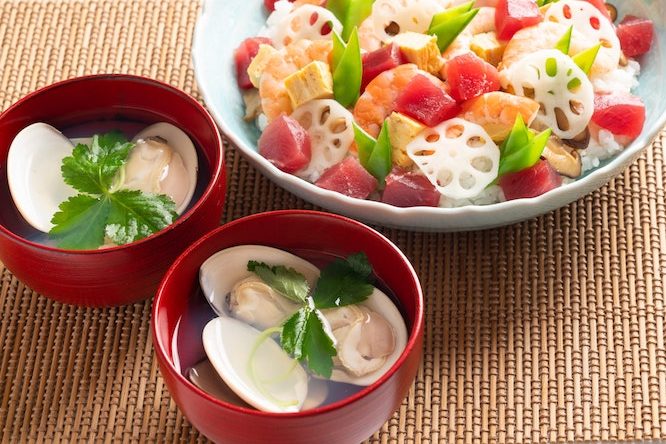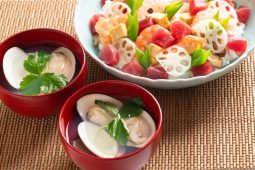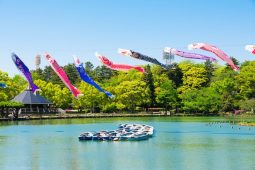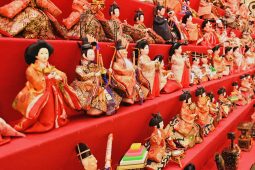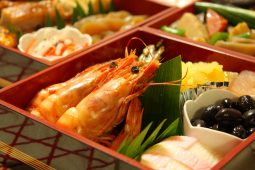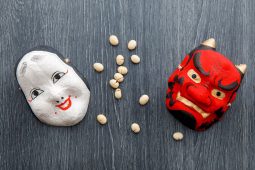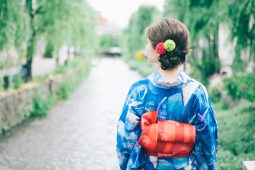Japan has a rich array of annual events and festivities that are celebrated through the seasons, each with their own special traditions, and each with their own special foods. In this article we are going to look at some of Japan’s most important seasonal foods, and examine their significance.
Oshōgatsu (January 1st — 3rd)
Osechi-ryōri, often called simply osechi, are the traditional foods that are eaten during Oshōgatsu (Japan’s New year holidays). Osechi are notable for their colorful variety, and are beautifully presented in stacked lacquered boxes called jūbako. Traditionally during the holiday season people are not supposed to cook, and most shops are closed, so all the foods in osechi are chosen because they will last for a few days. Many of the individual foods have a special meaning attached to them such as health or good fortune. Osechi is usually served with ozōni, a soup made with rice cakes and vegetables that differs greatly by region. Another tradition is to drink a special sake called otoso, which is spiced with medicinal herbs and is meant to bring you good health in the coming year.
Jinjitsu (January 7th)
Jinjitsu (literally “human day”) is an ancient festival originally from China which celebrates the creation of humanity. On this day it is traditional to eat a special rice porridge made with seven wild herbs called nanakusa-gayu (seven herb porridge) as these are believed to bring good health and a long life. It is a very simple dish, so it goes down well after all the rich feasting of oshōgatsu.
Setsubun (February 2nd)
Setsubun marks the traditional end of winter and is celebrated by scattering lucky beans (called fuku mame) throughout the home. Roasted soybeans will be thrown at somebody wearing a devil mask while shouting “Oni wa soto! Fuku wa uchi!” or “Devils out! Good luck in! “To bring personal good luck, people also eat one bean for each year of their life. Another tradition is to eat a special rolled sushi called ehō-maki (literally „blessed direction roll”). An Ehō-maki is a long uncut roll containing seven ingredients (the ingredients don’t matter but the lucky number does) and it should be eaten in complete silence while facing in a lucky direction. The lucky direction changes each year according to traditional astrology, but in 2021 it is east-south-east. This ehō-maki tradition originated in the western Kansai region but is now popular throughout Japan and you can buy the rolls in convenience stores and supermarkets.
Momo-no-Sekku (March 3rd)
These days Momo-no-Sekku (the Peach Festival) is more commonly known as Hina Matsuri (the Dolls’ Festival) or Onnanoko-no-Hi (Girls’ Day). This festival marks the season when peach blossoms are in bloom and is celebrated in the home by displaying a set of ornamental hina dolls which represent the ancient imperial court. There also a lot of special celebratory foods which are eaten on this day. Hina-arare are colorful rice crackers, hishi mochi are rice cakes colored pink, white and green, and shirozake is a sweet non-alcoholic sake that kids can enjoy too. The main dish is chirashi-zushi (literally “scattered sushi”) which is raw seafood and vegetables served on a bed of rice. This is accompanied by hamaguri—no-osuimono, which is a kind of clear soup with clams. The paired shells of the clams are meant to represent a happy couple, in the hope that girls can find good husbands.
Kodomo-no-Hi (May 5th)
Kodomo-no-Hi (Children’s Day) is a day to celebrate children and hope that they grow up strong and healthy. People fly colorful koinobori carp streamers on this day and children eat kashiwa mochi which are rice cakes stuffed with sweet bean paste and wrapped in oak leaves symbolizing strength. Steamed sweet chimaki dumplings made of glutinous rice and wrapped in bamboo leaves are also eaten on this day.
Doyō-no-Ushi-no-Hi (July/August)
Doyō-no-Ushi-no-Hi (Day of the Ox) falls on a different day each summer, but is traditionally believed to be the hottest day of the year. Eating unagi (eel) on this day is meant to give you the extra strength you need to survive the midsummer heat.
Chūshū-no-Meigetsu (September)
Chūshū-no-Meigetsu is the harvest moon. Traditionally moon-viewing parties are held and windows and balconies are decorated with susuki (pampass grass). Tsukimi dango (“moon-viewing dumplings”) are sweet round rice dumplings that are eaten at these parties.
Shichi-Go-San (November 15th)
Shichi-Go-San (“Seven-Five-Three”) is a day when three — and seven-year-old girls and five-year-old boys are dressed in kimono and presented at a local shrine. These children are given chitose ame (“thousand year candy”) which is a long, thin, red and white sweet symbolizing a healthy, long life.
Ōmisoka (December 31st)
Toshikoshi soba (“year-crossing noodles”) are eaten on Ōmisoka (New Year’s Eve). The long noodles symbolize long life, and because they are soft and easy to bite through they also symbolize breaking off any bad luck from the previous year.


